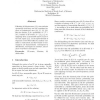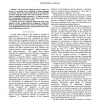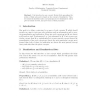EUSFLAT
2007
15 years 1 months ago
2007
Multiattribute evaluation of alternatives for the disposition of surplus weapons-usable plutonium on the base of fuzzy sets has been made.
EUSFLAT
2007
15 years 1 months ago
2007
The goal of this paper is to push forward the development of the apparatus of the Fuzzy Class theory. We concentrate on three areas: strengthening the universal quantifier, forma...
84
Voted
BIRTHDAY
2006
Springer
15 years 4 months ago
2006
Springer
Following M. Krachounov ([5]), max and min operations with fuzzy sets are considered instead of Lukasiewicz ones ([6], [7], [8], [9]). Her the domain F of a probability m : F [0, ...
111
click to vote
FUZZIEEE
2007
IEEE
15 years 4 months ago
2007
IEEE
One of the most important features of fuzzy set theory is its potential for the modeling of natural language expressions. Most works done on this topic focus on some parts of natur...
84
Voted
FUZZY
1997
Springer
15 years 4 months ago
1997
Springer
It is introduced a new concept: H-sets which generalises the notion of fuzzy sets and is based on the concept of hemilattice. Then, we extend the attribute-value conceptual spaces ...
133
click to vote
IEAAIE
1999
Springer
15 years 4 months ago
1999
Springer
This paper describes a new approach to model fuzzy sets using object-oriented programming techniques. Currently, the most frequently used method to model fuzzy sets is by using a p...
ESSLLI
1999
Springer
15 years 4 months ago
1999
Springer
We recall the concept of a linguistic variable and the representation of its values (i.e. linguistic terms) by means of fuzzy sets. In this framework adverbs are represented by fuz...
APSEC
2000
IEEE
15 years 4 months ago
2000
IEEE
It has been recognised that formal methods are useful as a modelling tool in requirements engineering. Specification languages such as Z permit the precise and unambiguous modell...
116
click to vote
IEAAIE
2005
Springer
15 years 6 months ago
2005
Springer
In this paper, a multi-objective genetic algorithm is proposed to deal with a real-world fuzzy job shop scheduling problem. Fuzzy sets are used to model uncertain due dates and pro...
ICNC
2005
Springer
15 years 6 months ago
2005
Springer
In this paper, we propose a new machine learning approach based on AFS (Axiomatic Fuzzy Sets) fuzzy logic, in attempt to provide a better model with interpretability. First, we wil...




